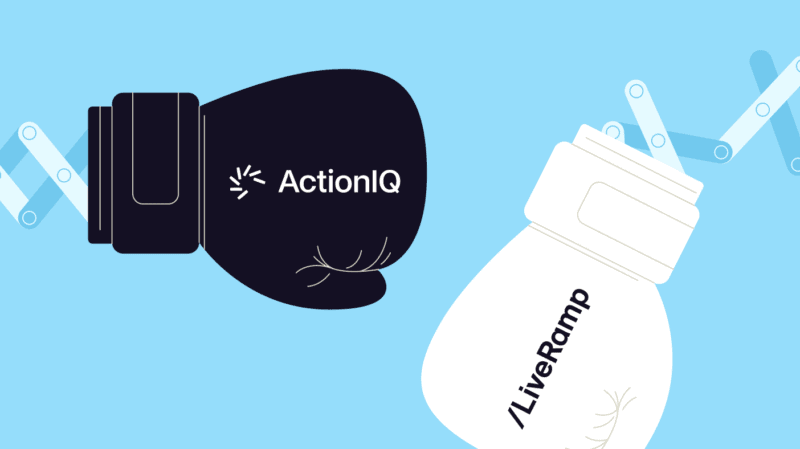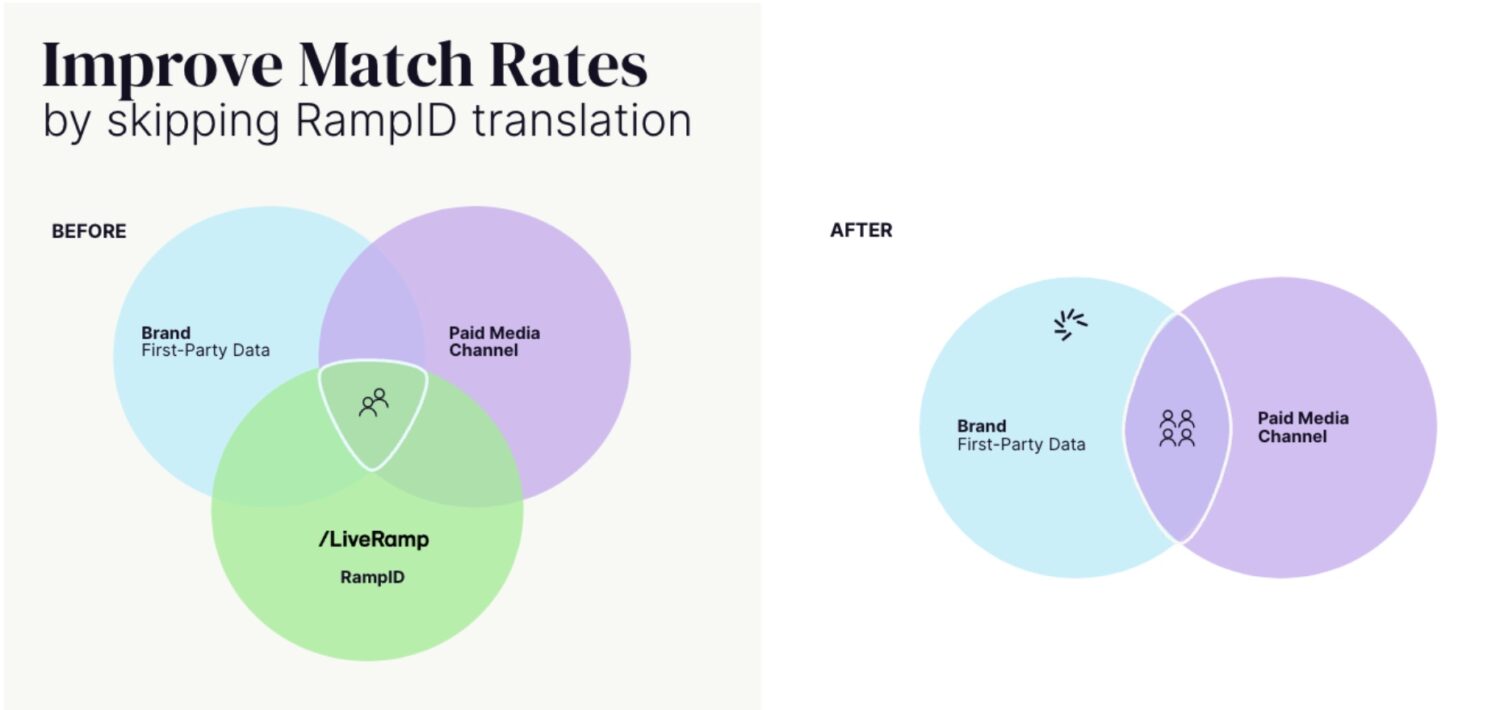Increase Match Rates and Decrease Costs: Your Guide to Leaving LiveRamp

It’s time to talk about the elephant in the adtech room — it’s time to talk about plummeting match rates, high acquisition costs and operational inefficiency — that’s right, it’s time to talk about LiveRamp.
We get it. You probably used LiveRamp back in the third-party cookie heyday and it was great, and it’s hard to let go and embrace change. But when third-party cookies and legacy solutions built on them have their last curtain call, you don’t want to be the only person left in the audience.
That’s why it’s time to get serious about future-proofing your advertising strategy with a more agnostic approach. In this article, we’ll take a look at the LiveRamp model, break down how and why it’s costing you performance and spend and offer alternative solutions that will give you the flexibility to grow and thrive in a (very) fickle market. We’ll also show you how ActionIQ does it better.
4 Reasons Why LiveRamp is Producing Low Match Rates at High Cost
Identity resolution costs are rising, and solutions like LiveRamp are to blame — below, we’ll take a look at the various costs associated with solutions like LiveRamp then later, we’ll show you how you can do it better.
1. Inefficient Processes Leading to Low Performance
LiveRamp’s process is manual, and requires a lot of effort from brands to set up their ad campaigns. Not only does LiveRamp’s manual process cause inefficiencies and lack of speed to market, but it also lacks any real-time data activation or micro-segmentation capabilities.
2. Lack of Control and Transparency
Brands are locked into LiveRamp’s tech ecosystem relative to the matching of a RampID to a person-level profile from the brand. For example, understanding if a unique profile was truly recognized and matched with a RampID, or was not recognized but a RampID was assigned anyways and then placed in a sandbox awaiting additional signals and/or an authentication event. There is very little understanding of this process, and a lack of trust in the matching process and resulting match rate performance numbers that are reported back to a customer.
3. Costly, Unreliable Onboarding Fees
LiveRamp’s high onboarding fees are expensive — and not necessary to onboard for channels like Meta, Google, Bing and Yahoo. In the wake of third-party cookie deprecation, walled gardens have made huge strides in their direct first-party activation capabilities in ways that connect with their own proprietary identity graphs. This means that organizations can activate directly to walled gardens without copying data to an onboarding solution first, which incurs added cost as well as inefficient workflow copying the data with an intermediary identity.
4. Hostage vs. Customer Dynamic
When all of your first-party data is transformed to that one identity currency, as the old adage goes – you are no longer a customer, you are a hostage. You are fully controlled and leveraged by that vendor, with very high barriers set forth in terms of shopping the market and cost negotiation. Between onboarding and/or ‘records under management’ fees, enterprise-level brands can easily find themselves being taxed $800k-$1.5M and upwards per year.
4 Ways to Leave LiveRamp for a Futureproof Solution
You’re on our blog so we get to be a little biased — with our complete customer experience solution, we have identity resolution capabilities that give you the tools and environment you need to grow. Along with the first ever composable identity solution designed for you to tap directly into your existing data investment. So here’s a look at what you get by replacing LiveRamp with a solution like ActionIQ.
1. Choose Your Identities
Vendors like LiveRamp built a black box ID graph (RampID) using their data (most being third-party data). A brand or publisher can access it — e.g., send their own signals to match against the vendor data — for a cost at the discretion of each vendor. Exploring these identities could be beneficial for brands looking to increase scale and reach, but it will require education to navigate the options. Some of these ID graphs are built via deterministic links, typically hashed PII, while others use probabilistic links. With ActionIQ, you can leverage a private ID graph composed of any ID you need, generated by your systems or provided by vendors, for both anonymous and known users.
2. Activate Directly on Paid Properties
Rather than going through an intermediary like LiveRamp to activate audiences, you can connect directly to walled gardens — without the costly middleman. When brands embrace first-party data in their acquisition strategy, they experience higher match rates by activating directly, rather than going through an onboarder — which would require a translation of first-party data to their system, and another translation back to the walled garden. With a direct connector to primary channels within a brand’s media mix, brands can activate audiences easily.

3. Future-Proof Your Strategy With a Partner Ecosystem
Advertisers want to implement the ID solution that has the greatest reach and scale — And publishers want to implement the one that has the most buyer adoption. The reality? No single ID solution will win the entire market and become the new gold standard for replacing anonymous identifiers. Instead, brands should prepare for a fragmented future with multiple identifier replacements. It’s critical to have the flexibility to adapt to a changing market and avoid lock-in by adopting an agnostic approach to identity and data clean room. With ActionIQ, you can create an interoperable advertising stack from an ecosystem of solutions such as: Acxiom, Neustar, Merkle Merkury, Infosum and Data Axle.
4. The First Ever Composable Identity Solution
The location in which enterprise brands are resolving identities is changing. Sending your data to a bundled solution to resolve identities will only increase costs for you to pay expensive onboarding fees, increase risk and decrease efficiency to send copies out of your central system, and cause redundancies in workflow. Rather — brands can resolve identities where they live, centralized in one location within their data warehouses. With a composable approach, systems work together to decrease cost and keep the data in one place by resolving them right in the warehouse. ActionIQ recently announced collaboration with Amazon Web Services (AWS) to offer that ease in identity resolution.
How ActionIQ and LiveRamp Stack Up
| ActionIQ | LiveRamp | |
|---|---|---|
| Data Sources (Primary) | 1st-party data | 3rd-party data |
| Data Type | PII, non-PII | PII, non-PII |
| Data Marketplace | ❌ | ✅ |
| Data Collaboration | Available integrating with partners | Via Safe Haven product |
| Identity Deduplication on Owned PII First-party Data | ✅ | ❌ |
| Identity Stitching Using Vendor ID Graph | Available integrating with another vendor graph (not provided by ActionIQ) | Via LiveRamp graph (RampID) |
| Look-alikes | ✅ | ✅ |
| Audience Segmentation | ✅ strong and self-service | ✅ limited |
| Orchestration | ✅ | ❌ |
| Real-Time | ✅ | ❌ |
| Identity for Activation/Syndication | Any addressable ID | RampID |
| Integration with Paid Media | ✅ direct integration with major walled gardens and DSPs | ✅ extensive integrations in the advertising ecosystem |
Results From Brands Who Left LiveRamp
Brands who have approached identity differently — leading with first-party data — have experienced higher match rates and bolstered their acquisition program with a more agile, flexible and agnostic approach. Here’s what brands have gotten after leaving LiveRamp in favor of ActionIQ’s futureproof identity solution.
- Increased Match Rates. With a direct connector to primary channels within a brand’s media mix, brands who partner with ActionIQ can activate audiences easily. By skipping the translation to a RampID as an intermediary identity, brands improve match rates (with ActionIQ, by up to 500%)
- Fast and Easy Audience Activation. By activating directly with more granular segments, brands who replace LiveRamp with ActionIQ increase campaign conversion and decrease time to market.
- Cost Savings and Revenue Growth. Eliminate your expensive and inefficient legacy LiveRamp tech with proven future-proof solutions and optimize targeting with a business-friendly tool to increase control, test and reduce customer acquisition costs.
Futureproof Your Identity Strategy Now for Connected, Flexible CX
Now is the time to take a good hard look at your adtech stack to make sure you have the tools you need to grow and thrive in an advertising environment that seems to change every week. By adopting an agnostic, first-party forward identity strategy you can connect your customer experience.
Download The Enterprise Guide to Acquisition Marketing Powered by First-Party Data or get in touch with our experts to learn more about CX Hub’s Identity framework and how you can get started.





